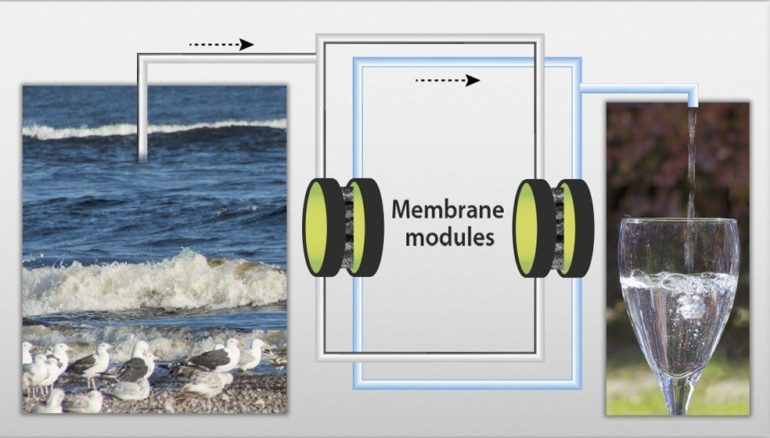Hooman Chamani, a Ph.D. candidate in Ottawa, is motivated by one thing: To address the global water crisis in an environmentally friendly manner. It may sound simple, but until recently, it was not.
Now, thanks to his work alongside Dr. Christopher Lan and Dr. Takeshi Matsuura, professors in the Department of Chemical and Biological Engineering at the University of Ottawa, and their research team, Joanne Woloszyn and Dr. Dipak Rana, a nature-friendly—yet commercially viable—solution that improves upon current desalinization techniques has been identified.
Their work, “Pore wetting in membrane distillation: A comprehensive review,” was recently published in the prestigious scientific journal of Progress in Materials Science and identifies commercialized “membrane distillation” as a green solution to clean, drinkable water.
“With the commercialized membrane distillation at large scale, we can move toward a solution for the water crisis,” explains lead author Hooman Chamani.
The Blue Planet
While the Earth is covered mostly with water, the availability of natural freshwater is relatively low, representing only 2.5 percent of its hydrosphere, with the remaining 97.5 percent being saline water.
With the population growing, so is the demand for water, which is putting pressure on its limited quantity.
“More than two billion people all over the world do not have access to safe drinking water,” explains Hooman Chamani. “Even in Canada, blessed with abundant freshwater resources, you can find regions that suffer from water shortages. Human activities such as urbanization and industrialization fuel the problem by polluting available freshwater reserves. In addition, change in weather due to global warming in recent decades is greatly contributing to the global water shortage.”
Desalination is the process of removing salts and minerals from saline water to obtain fresh water.
“The state-of-the-art technique for seawater desalination is reverse osmosis,” says senior author Christopher Lan. “However, a major disadvantage of this technique is its inability to desalinate highly concentrated brines (salt water). An alternative method for desalination, which is better equipped to handle highly saline solutions, is membrane distillation.”
Membrane pore wetting
So, if membrane distillation is a better way to get clean water, why hasn’t it been widely commercialized yet?
According to the researchers, the most predominant drawback of membrane distillation is called “membrane pore wetting'”.
“If this problem is resolved, it is highly likely that membrane distillation will replace reverse osmosis as the go-to desalination technique,” says Takeshi Matsuura. “We have been trying to make membrane distillation commercially more viable, especially by addressing the pore wetting issue from its fundamental aspect. In the review article, we have presented a comprehensive review on recent developments, including our own, to prevent the membrane pores from being wetted.”
“In our review, we discuss all aspects of pore wetting, which is the most critical challenge of membrane distillation, in order to provide better insight into this undesirable phenomenon with the most advanced knowledge in this field.”
Safe for us and the environment
“The reject brine of reverse osmosis is highly concentrated, and its disposal has become a critical challenge for the environment,” says Hooman Chamani. “Therefore, treating highly saline brines using commercialized membrane distillation helps not only provide drinking water to more people but also manage brines and keep the environment safe.”
But it’s not a simple task.
“After many years of working in this field, our group identified pore wetting as one of the most critical issues of membrane distillation,” concludes Dr. Christopher Lan. “Hooman Chamani challenged this problem, resulting in a number of high-impact publications. He is one of the best Ph.D. students we have ever had in our lab, and he’s driven by one goal: to find a solution for the water crisis by commercializing membrane distillation at a large scale.”
Making seawater drinkable in minutes
More information:
Hooman Chamani et al, Pore wetting in membrane distillation: A comprehensive review, Progress in Materials Science (2021). DOI: 10.1016/j.pmatsci.2021.100843
Provided by
University of Ottawa
Citation:
One student’s mission to protect the world’s most precious resource (2021, August 25)
retrieved 25 August 2021
from https://phys.org/news/2021-08-student-mission-world-precious-resource.html
This document is subject to copyright. Apart from any fair dealing for the purpose of private study or research, no
part may be reproduced without the written permission. The content is provided for information purposes only.


